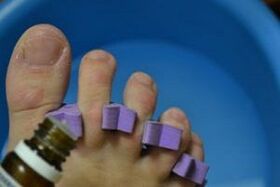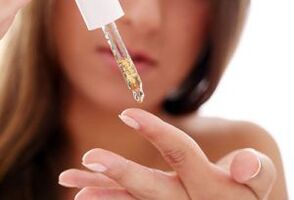
A pathogenic fungal microbe can infect toenails when going to a sauna, swimming pool, wearing someone else's shoes or socks, or using unsterilized pedicure kits.
Doctors make a diagnosis based on visual examination and laboratory test results, and then prescribe medication to treat toenail fungus. In the initial stages of the disease, external agents produce good results - drops, creams, ointments, sprays and solutions.
In advanced cases, treatment will be lengthy and expensive - it will be necessary to use a set of drugs, including systemic pills.
Benefits of Antifungal Drops
The first advantage of drops is their ease of use. They come in a compact bottle with a dispenser that allows you to accurately dispense drops for nail treatment without resorting to other medical accessories. The restrictor on the dispenser allows you to apply the product point by point without wasting the medication in vain. This makes this form of drug economical.
Safety is the second benefit of drops for nail fungus. The drops act on the nails, the superficial layer of the skin and do not penetrate into the blood.
This makes them safe to use, unlike toxic drugs that are administered orally. Also, apply carefully to the nail without touching the surrounding skin and nail folds. This eliminates irritation and allergies.
The third major advantage of fungal medicines in the form of drops is their effectiveness. The drug is absorbed well, does not stain clothes, does not smear. Drops directly affect the lesion and respond quickly to infection. Even inexpensive antifungal drugs can defeat advanced onychomycosis as part of a complex treatment, eliminating the need to remove the nails.
How Drops from Fungus Work

After identifying the causative agent of the disease, your doctor will tell you which toenail fungus drops are most effective. Modern medicines act on fungi in complex ways - in two directions at the same time:
- Fungicides - destroy fungal spores and the fungus itself;
- Bacteriostatic - Stops the reproduction of fungi at the cellular level.
Since the preparation is so complicated, it is possible to choose the best treatment for the nails, and there is no chance for fungi and bacteria to multiply on the nails. Another effect of the drops is to eliminate inflammation and improve cell regeneration. When used externally, the components of the drops accumulate in the nail plate in optimal concentration. The drug blocks the synthesis of ergosterol - the compound that forms the basis of the cell membranes of fungal microorganisms. As a result, the life process of the fungus is disrupted, with the result that the pathogenic flora dies.
As mentioned above, in order to achieve such an effect, drops against nail fungus must be prescribed by a competent physician. He will prescribe the necessary medication, dosage, and choose the duration of the course of treatment.
Indications for the use of onychomycosis drops
Drops are used for damaged nails on the hands and feet, skin showing signs of fungus, ringworm and pityriasis versicolor. Symptoms of drops and other external nail preparations prescribed by a dermatologist for fungus:
- Inflammation, peeling, and redness of the skin between the toes;
- Itching and burning sensations in the feet, between the fingers, or near the nails;
- pain, signs of inflammation around the nails;
- streaks, grooves, and spots on the nail plate;
- Nail color change, deformation, thickening, delamination.
The above signs indicate a fungal infection. If you consult your doctor right away, treatment will be inexpensive and you can get your problem resolved quickly. Onychomycosis refers to an infectious disease that is not just a cosmetic discomfort but a danger to disease carriers and others.
In advanced stages, the fungus can cause poisoning of the body, decreased immunity, and complications. Problems don't resolve on their own; over time, the disease can develop without proper treatment.
Contraindications for fungal drops
Any drug, including antifungal drops, has its own contraindications and side effects. You will need to read the instructions before starting treatment. The points that do not allow the use of drops are: individual intolerance to the drug, age up to 12 years, pregnancy and feeding, presence of wounds and suppuration. Using the drops can cause burning, itching, redness, and peeling.
Drops have less contraindications than systemic antifungals, however, a doctor should prescribe them.
Effective drops for fungi

First, fungal-infected nails are steamed, cleaned, and dried before instillation.
The process is repeated twice a day for up to six months (time depends on how long healthy nails have grown). The drops can cause peeling and itching of the skin, but you should not cancel treatment.
Drops are prescribed in the initial stages of the disease and in the prevention of recurrence.
Reviews of using drops noted their cost-effectiveness and ease of use. Contraindications are rare and side effects are rare. But the drops help to quickly neutralize the fungus and restore the beauty and health of the nails.
In advanced cases, drops are used as part of complex treatments, including medication, dietary modifications, hygiene procedures, medical pedicures, and more. Doctors choose the exact treatment plan individually for each patient.
















